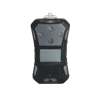
Gas Detectors by Toxic and Harmful Gases
What is a Toxic Gas?
Toxic gases are substances that, when released into the atmosphere, pose significant health risks to humans, animals, and the environment due to their poisonous nature. These gases can be naturally occurring or man-made and are characterized by their ability to cause harm through inhalation, skin contact, or ingestion.
Common poisonous gases include Carbon Monoxide (CO), Hydrogen Sulfide (H2S), Chlorine (Cl2), Ammonia (NH3), and various Volatile Organic Compounds (VOCs). Each of these gases has distinct properties and effects on living organisms.
Exposure to hazardous gases can result in a wide range of health problems, from mild irritations and respiratory issues to severe poisoning and death. The severity of the impact depends on factors such as the concentration of the gas, duration of exposure, and an individual's overall health. Hazardous gases can be released from industrial processes, chemical reactions, natural events like volcanic eruptions, or even household products. Using a gas detector and properly handling toxic substances is essential to minimize the risk of accidental exposure.
Types of Toxic Gases
Toxic gases can be harmful or even deadly to humans and other living organisms when inhaled, absorbed through the skin, or ingested. There are many different types of toxic gases, each with its own set of properties and health effects. Here are some common types of poisonous gases:
ClO2
Chlorine Dioxide
CH2O
Formaldehyde
HCN
Hydrogen Cyanide
HF
Hydrogen Fluoride
NO
Nitric Oxide
NO2
Nitrogen Dioxide
NOx
Nitrogen Oxides
COCl2
Phosgene
PH3
Phosphine
Notes
- Carbon Monoxide (CO): Included despite IDLH >1000 ppm due to extreme toxicity (binds hemoglobin).
- Formaldehyde/ (CH4): Excluded (non-toxic, only asphyxiants).
It's essential to be aware of the potential dangers associated with these toxic gases and take appropriate safety precautions, such as proper ventilation, protective equipment, and monitoring with gas detectors when working with or around them.
Gas Detectors for Toxic and Harmful Gases Detection
Gas detectors are essential devices used to monitor and detect the presence of poisonous gases in various environments, including industrial settings, laboratories, homes, and public spaces. GasDog detectors can monitor a range of toxic gases, including Carbon Monoxide, Chlorine, Chlorine Dioxide, Formaldehyde, Hydrogen Chloride, Hydrogen Cyanide, Hydrogen Fluoride, Hydrogen Sulfide, Nitric Oxide, Nitrogen Dioxide, Nitrogen Oxides, Ozone, Phosphine and Sulfur Dioxide. These gas detectors & monitors play a crucial role in ensuring the safety of individuals and preventing accidents or health hazards related to exposure to harmful gases.



